In the article we will talk about how to make a sewer in a private house with our own hands. Consider practical schemes on the basis of which it is possible to build a drain system. Here is a description of the phased production of sewers, as well as useful tips and tricks. In the manufacture of a sewerage system, it is necessary to take into account many factors, including the presence of groundwater, the quality of the soil. Well, let's take a closer look at how to make a sewer in a private house with your own hands.
General rules and scheme
When compared with city apartments, not every private house has all the communication systems. For this reason, the owners lay them on their own in order to improve comfort in the house. It is worth noting that if the equipment of this system, together with the water supply, is initially laid down in the project, then there are no problems withthere will be no construction. It will be more difficult if you have to make a sewer system in an already built house. But what will the correct sewerage in a private house look like in this case? Can I make it with my own hands?
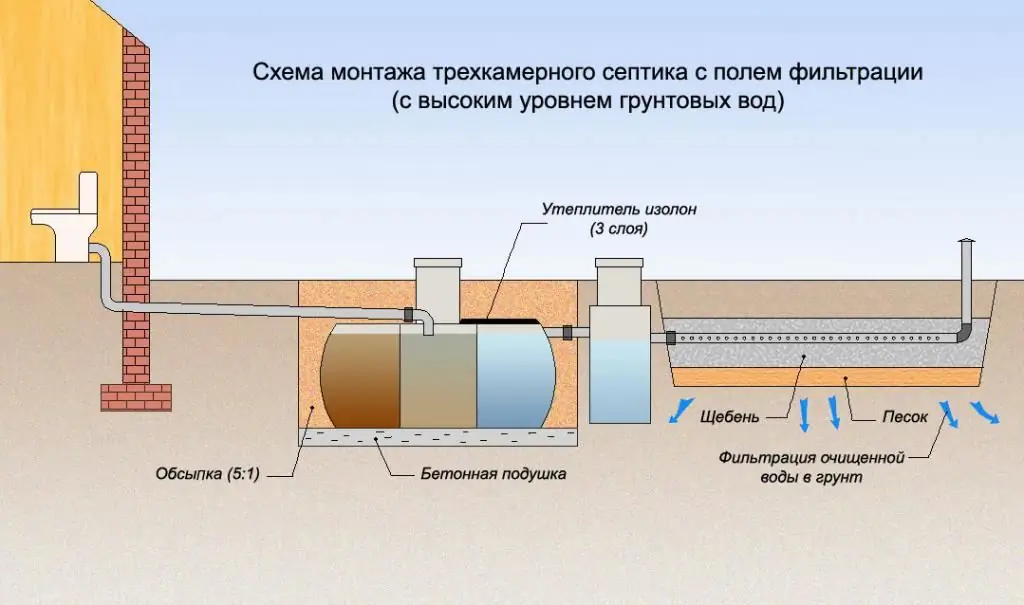
The easiest option for such a sewer is if the shower and sink are installed inside the building, and the toilet is outside. In this case, you can do without the work of laying pipes, as well as the installation of various kinds of treatment facilities. Such a scheme implies that wastewater will be discharged through a pipe from the house to the sewer pit. This is one of the options for proper sewage in a private house. It will not be difficult to draw up and implement a project with your own hands.
A more complex option - in which the shower, toilet and sink are in the building. But if you make incorrect calculations or violate construction technology, there may be a high risk of pollution of your site, as well as water bodies, if they are near the house. In this case, it is better to use septic tanks. Please note that it is most reasonable to place the bathroom, kitchen and toilet as close to each other as possible. You need to carefully consider the sewage system in a private house. With your own hands, you can draw up a plan for the location of all highways on the site. This will make installation easier.
In this case, you will be able to make one collector into which water from all sources will merge. Through it, all waste water will flow into a septic tank or sewer. Note that this is the most popularsewerage device in a private house. It is not difficult to carry out all the installation work with your own hands.
Choosing a scheme for a one-story house
In order to choose the right sewerage system scheme, the following points must be taken into account:
- Do you live in this house permanently.
- At what level is the groundwater.
- How many people permanently live in the house.
- How much water is consumed daily by residents and household appliances.
- Type of soil, its structure. It depends on how the installation of sewerage in a private house will be carried out. You can do everything with your own hands, but working with soil is the most laborious.
- Climatic conditions in your area.
- Total area of the site. It will allow you to determine the availability of available areas for the installation of a cleaning system.
- Regulations of normative documents, in particular, SNIP.
In total, two large categories of sewage systems can be distinguished. These are cleansing and accumulative. If you classify in more detail, then you will be able to choose the most suitable option for certain operating conditions. It is worth noting that even schemes of the same type have significant differences.
The cesspool is often used. But it is best to use it if you do not live in the house permanently. This option is ideal for a summer cottage. Groundwater should be no higher than 1 m from the bottom of the cesspool. If they are too high, then storage tanks must be used. They have tankssealed, so you won't pollute the soil with waste.
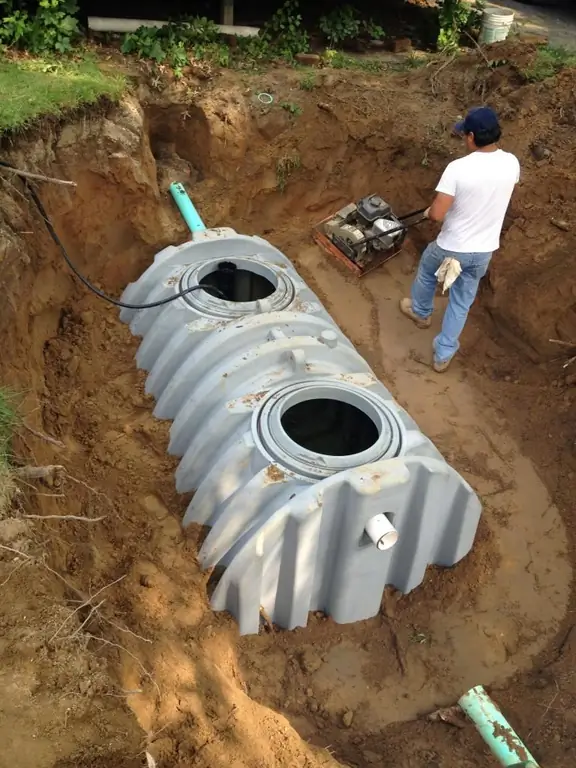
In addition, groundwater will not get inside the septic tank. But this design has drawbacks. Firstly, you will have to spend extra money on sewage services. Drains will have to be pumped out from time to time. Secondly, you need to provide free access for equipment to the septic tank. Be sure to take into account all these points when installing a sewer in a private house with your own hands.
Varieties of sewer systems
The simplest are single-chamber septic tanks. Their designs and principle of operation are approximately the same as those of cesspools. This scheme works well if the groundwater is not very high. In the same case, if people constantly live in the house, and the groundwater is too high, it is not recommended to use a single-chamber septic tank when arranging sewage in a private house with your own hands.
Two-chamber septic tanks also depend on groundwater. It is necessary that the bottom of the septic tank is at a distance of more than 1 meter from their level. In order for a two-chamber septic tank to work normally, crushed stone and sand must be replaced at least once every 5 years. The best can be called septic tanks with installed biological filters. They are suitable for houses in which people constantly live, there are no requirements for the level of groundwater. Making a simple sewer in a private house with your own hands using this technology is not difficult.
In order to recycle waste, usemicroorganisms. It is enough to pour them into the sink or toilet so that they get into the septic tank and start working. True, for normal operation, you will have to connect the equipment to the mains. You can make such a sewer with your own hands for a one-story private house. But first of all, you need to look not at the number of storeys, but at the volume of wastewater.
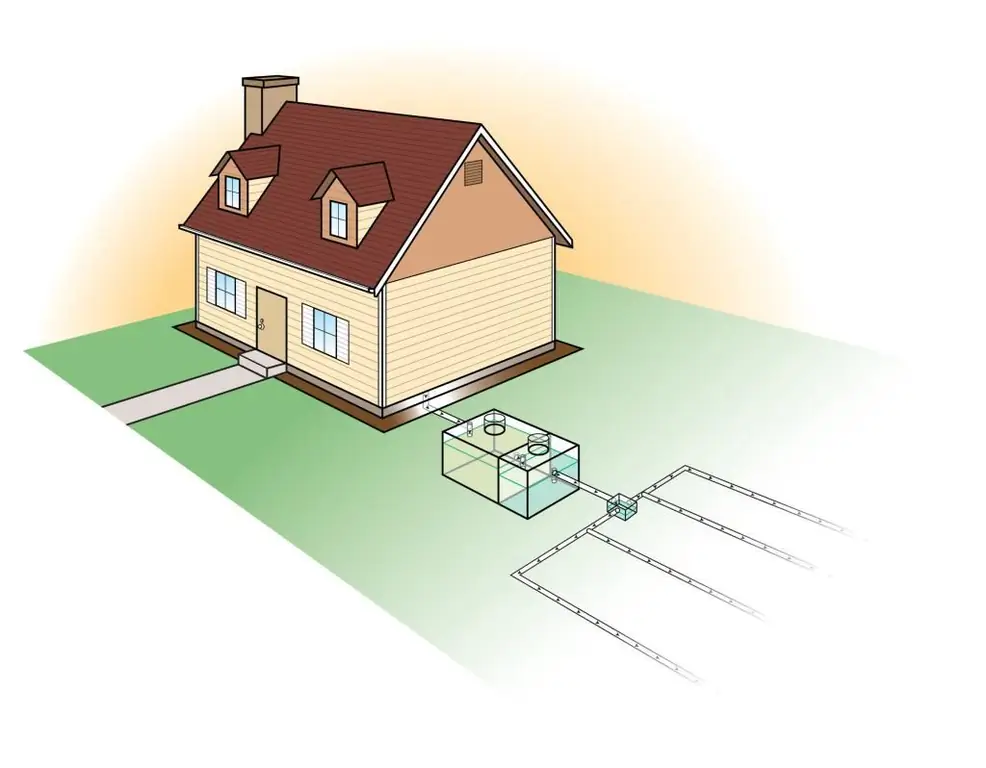
There are septic tanks with a filtration field. They allow you to immediately perform double cleaning - biological and soil. One tank is divided into two parts. It is possible to mount such a sewer only if the groundwater is at a depth of about 3 m. Also, a large area is required for construction. It is recommended that when installing a sewerage system in a private house with your own hands, keep a distance of at least 30 m from water sources and nearby buildings.
There is a so-called forced air system or aeration tank. Its construction is quite expensive, but due to their advantages, they justify this investment. There are no installation restrictions, but you will have to supply power. It is also necessary that someone constantly monitor the functioning of this system. The cost of sewerage is quite high, starting from two hundred thousand rubles.
How to sewer properly
The construction of any communication must be carried out according to a project developed and approved in advance. It is usually accompanied by a diagram that allows you to make the internal and external wiring of the sewer system. If you wish, you canstart with the arrangement of the internal sewerage system. It is easy to make it in a private house with your own hands, it consists of:
- Highways.
- Stoyakov.
- Zones for connecting plumbing.
By plumbing we mean showers without trays, sinks, toilets, bathtubs. A pipe is installed at the end of the internal system. This element is approximately on the same level with the foundation of the house. And this moment must be taken into account when we do sewerage in a private house with our own hands.
When arranging an external sewage system, you will have to make a pipeline. It will allow you to divert all drains from the house to treatment or storage equipment. After the approval and manufacture of the project, it is necessary to determine how many pipes you need. It is necessary to determine not only the size of the length, but also the diameter. Be sure to calculate how many consumables you will need for installation.
How to choose a place to install a septic tank
When you equip the sewer, it is very important to find the right place to install a septic tank. Pay attention to these points:
- How deep is groundwater.
- Relief of the site where the work is planned. Please note that drains should flow to the septic tank by gravity.
- How deep does the ground freeze in winter.
- Are there sources of drinking water on the site.
- What is the structure of the soil.
Sandy soil is loose, so liquid can easily pass through it. In this case, there is a high probability thatthat groundwater will be polluted by sewage waste. If you decide to install a septic tank, then it is extremely important to know what distances you need to maintain from various objects:
- You need to step back from the residential building at least 5 m.
- Trees must be more than 3m away.
- Drinking water sources should be more than 30 m away.
At the first stage, it is also necessary to determine how the sewer truck will drive to the septic tank.
How to make an internal sewage system
It is extremely important to mark all points on the internal sewerage scheme. First you need to install the central riser. It is advisable to make it from a pipe with a diameter of 110 mm. In order for all gases to quietly leave the house, you need to put it in such a way that the upper edge goes to the attic or protrudes above the roof. Please note that the central riser must be placed at least 4 m from the windows of the house.
Next, you need to lay horizontal pipelines of internal sewerage in a private house. You can do this work with your own hands, since you do not need to use special equipment. If you install inspection hatches, this will allow you to easily monitor the state of the entire system, and, if necessary, clean it.
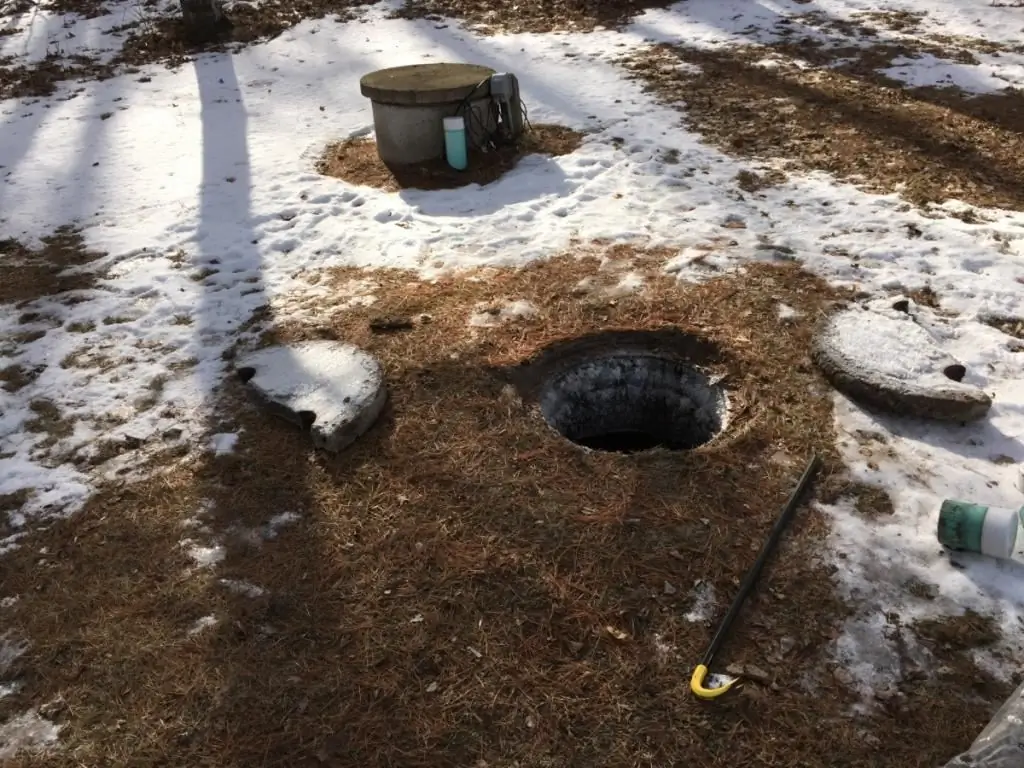
Inspection hatches are best placed at the lowest point, as well as above the toilet. Each plumbing fixture must have a siphon with a water seal. He will allowcompletely eliminate the ingress of unpleasant odors into the rooms. Try not to turn the pipes at right angles. In this case, you will significantly complicate the movement of wastewater.
The pipe that comes from the toilet must be connected directly to the system. For this, a pipe with a diameter of more than 100 mm is used. Bath and sink can be connected with pipes with a diameter of even 50 mm. The line must be placed at such an angle that the free movement of fluid is ensured. Be sure to make a blank in the foundation. It is through it that the laying of sewerage in a private house will subsequently be carried out. With their own hands, these works are carried out without labor costs if they are done at the construction stage.
It is recommended to install a check valve in this place, it will not allow wastewater to enter the internal system. If you absolutely need to make a right angle turn, then it is best to take two 45-degree corner pieces. And make a turn out of them.
Begin preparation for installation
The design of a septic tank is nothing more than a collector of two chambers. Its sections are connected by means of an overflow pipe. First you need to dig a pit, its depth should be about 3 m. The diameter should be chosen based on how much the septic tank needs to be made. It depends on how many people permanently live in the house. The pit can be dug both manually and with the help of special equipment.
At the bottom you need to equip a sand cushion. Its thickness should be no more than 15 cm. After that, formwork from boards or chipboard is installed. It is desirable to strengthen it with reinforcement. Next, perform the dressing with steel wire and make two holes in the formwork. In them you mount trimmings of sewer pipes. So you can make a main entry zone, as well as an overflow pipe that will connect the sections.
Now you can concrete the formwork. In order for the solution to be distributed as evenly as possible inside, you need to use a vibrating tool. Please note that the walls of the septic tank must be monolithic, so they must be filled at a time.
Installation of external sewerage. We equip a two-chamber septic tank
At the bottom of the first pharmacy you need to pour concrete. As a result, you will get a sealed section, which will be used in our system as a sump. In it, solid and large fractions will be separated from wastewater, they will all settle at the bottom. At the top of the compartment will be the accumulation of purified water. And an overflow pipe is installed on top, with its help water will enter the second compartment. By the way, if you use aerobic bacteria, you can also increase the degree of decomposition of solid elements.
In the second compartment, the bottom can be omitted. The chamber is made of concrete rings, or it is poured with cement, as in the previous case. The diameter of the compartment should be about one and a half meters. But at the bottom it is necessary to make a pillow of gravel, rubble or pebbles. As for the overflow pipe, it must be inclined by about 3 cm per meter. Think in advance how the sewerage wiring in a private house will look like. Do-it-yourself installation of all connectionsis carried out only under the condition of high-quality sealing of the joints.
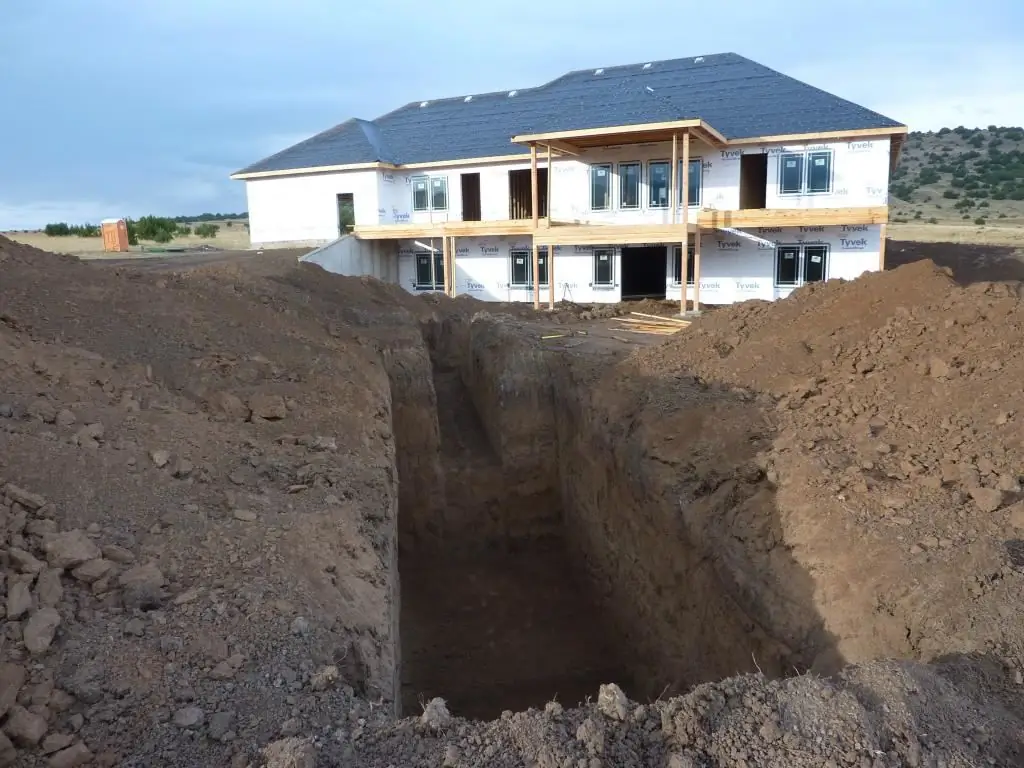
Very often used two-section design. Although you can easily increase the number of compartments - this will ensure the maximum degree of cleaning. As for the floors, they can also be done independently. To do this, pour the solution over the septic tank. Be sure to make reinforcement. The alternative is reinforced concrete slabs.
It is imperative to install an inspection hatch, with its help you will control the filling of the section and the hood. After installation, you need to fill the pit with sand or soil. The septic tank from large fractions should be cleaned approximately once every 2-3 years.
In fact, the step-by-step construction of any system looks like this:
- planning;
- preparatory work on the site - clearing, marking;
- earthworks;
- mounting the internal system;
- installation of a septic tank (tanks);
- main line installation;
- connecting and checking pipelines.
How to properly lay a pipeline
From the exit of the internal sewer system to the septic tank, it is necessary to lay a highway. Moreover, it should be located under a certain slope, due to which the outflow of all waste fluid is ensured. The larger the diameter of the pipe, the smaller the angle is needed in order for the line to work normally. On average, the slope should be about 2 degrees. The main line must be lower than the freezing level of the soilwinter.
Usually this is about 1 meter, but depending on the region, this figure may increase or decrease. If you live in a warm region, then there is no need to deepen the pipes much. It is enough to lay them at a depth of about 70 cm. Moreover, at the bottom of the trench, before mounting the pipes, it is necessary to fill in the sand and carefully compact it. This will securely fix the pipes and prevent their destruction when the soil shifts.
The best option for giving would be laying the highway in a straight line from the house to the septic tank. Of course, if necessary, turns are allowed. But in the place where the pipe turns, you need to equip a manhole. It is allowed to use both cast-iron and plastic pipes designed exclusively for arranging an external sewage system.
Minimum pipe diameter is 110mm. All joints must be treated with sealants. It must first be covered with sand, then with soil. In the event that it is not possible to lay the highway at great depths, it will need to be insulated. Thermal insulation is used for this.
Is it possible to do without pumping out
Two- and three-chamber septic tanks, as a rule, do not require pumping. In the event that the system has two tanks, the sump should account for about 3/4 of the entire system. In the case of 3 chambers, the sump must occupy at least half of the volume. In the very first section, heavy fractions settle. As it fills up, a relatively clean liquid flows into the next compartment. It separates the lighterfactions.
And already the third section is designed for complete wastewater treatment. After it, the effluents are fed into the filtration field or a drainage well. It is imperative that all system containers are sealed.
Such designs, of course, need to be pumped out. But it does not need to be produced as often as in conventional septic tanks. And you can pump out using a fecal or drainage pump, the cost of such a unit starts from 2000 rubles. With the help of such equipment, you can even remove the sediment that accumulates in the sump. Drainage and fecal pumps are not afraid of large particles getting inside. It should be noted that the frequency of pumping depends on the size of the tank and the amount of water that is produced by the house.
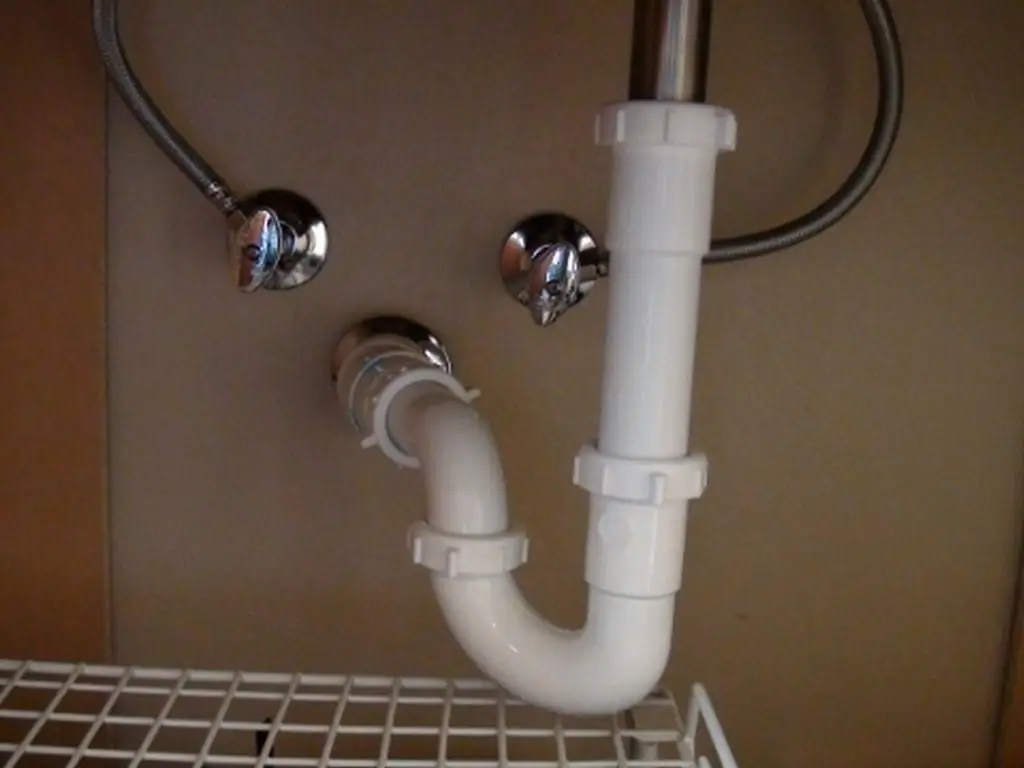
Be sure to clean if the sludge has reached the level of the overflow pipe. It is necessary to take into account that in one year from 120 to 180 liters of precipitation will accumulate in the tank. Knowing this data, you can find out how often cleaning should be done. If you do not know how to calculate the volume of a septic tank that will work without pumping, use a simple formula.
The daily rate of water consumption per person is about 200 liters. And it must be multiplied by the number of people living in the house, and then add another 20-25%. This volume is enough for the septic tank to work quietly without pumping.
In case the groundwater is high, a concrete slab must be laid at the bottom of the pit or acoupler. As for the size of the pit, it should be 20 cm larger on all sides so that formwork can be arranged without problems and walls of normal thickness can be made.
Recommendations for sewer construction
Polypropylene pipes perform very well, as they are environmentally friendly, have a good margin of safety, low weight, and also conduct heat well. Effluent is treated with bacteria that feed on organic waste. Therefore, it is extremely important to provide access to clean air so that microorganisms function normally. It is for these reasons that the cost of organizing an autonomous sewage system turns out to be much higher than installing a simple septic tank.
The autonomous type system has the following advantages:
- High level of wastewater treatment.
- Unique aeration cleaning system.
- There are no system maintenance costs.
- There is absolutely no need to purchase microorganisms.
- Small size.
- No need to call a sewer truck to clean the sewer.
- You can mount such a system even in the case of high groundwater.
- There are no smells from the autonomous sewer.
- High system resource. If everything is done correctly, following all the requirements, then such a system will last up to 50 years.
Some tips for installing an autonomous sewer
As in the case of septic tanks, the pipeline is mounted at an angle. It is recommended to make a slope of about 2..5 degrees. In case ifyou ignore the requirements, the drains will not drain well. When laying the highway, make sure that all its elements are fixed as securely as possible. In order to completely eliminate the risk of deformation of the highway and displacement during subsidence of the soil, it is necessary to carefully compact the soil at the bottom. In fact, making an autonomous sewer for a private house with your own hands is as simple as making a septic tank. The hardest part is working with the ground.

The base will be much more reliable if the bottom is poured with concrete. Try to install the pipes in a straight line. Turns are not recommended. All joints must be treated with sealant. You can use liquid clay for this. Please note that when using pipes with a diameter of 50 mm, it is allowed to make a maximum length of no more than 5 m. If you use pipes of 100 mm, then the length of the straight section can be a maximum of 8 m. And keep in mind that the entire septic tank must be located at least in 10 m from residential building. Therefore, you need to choose pipes with a larger diameter.
Construction of an autonomous sewer type by yourself
As in the case of septic tanks, you first need to choose the best place to install the tank. After that, start earthworks. In order to install the container, you will need to dig a pit. Its dimensions should be approximately 30 cm larger than the container. Please note that it is possible to place a biofilter and a septic tank in the same pit.
Afterafter the foundation pit was dug, it is necessary to make trenches along which the highway will be laid. At the bottom of the pit, it is desirable to make a pillow, on top of which pour concrete. After the final hardening of the solution, you can install a plastic or concrete container. To fix the structure on the bottom, it is recommended to use cables.
The next step is the assembly of the sewerage, as well as the connection of the main. It is necessary to think over the entire design scheme in advance. At the same stage, the biofilter blocks are filled. For this, you can use both expanded clay and absorbents. After installing the entire system, the trench must be covered. It is allowed to use a cement-sand mixture, soil and sand.
It is recommended to alternate all these mixtures, and also carefully tamp. It is recommended to fill the main line with sand first, and then only with soil. Connecting the entire system is possible only after the final check. As you can see, it is not very difficult to carry out the installation yourself. And if you provide revision holes, then it will not be difficult to clean the sewers in a private house with your own hands. There are a large number of ready-made structures on sale, so the manufacture of sewers is simplified many times over.
A little about the cost of sewerage
Of course, if we carry out sewerage in a private house with our own hands, then we can use the services of experienced builders. That's just they will require a tidy sum for the work. The cost directly depends on such nuances:
- Are there any peculiarities during earthworks. For example, do you needform a pit or trench.
- Is there a need to install a system that will carry out soil cleaning.
- The cost of installing a sewer for 1 m. On average, they take from 35 rubles per linear meter.
- Do I need to mount additional equipment.
- Is there a need to install additional structures to drain already treated water.
As a rule, during the construction of turnkey septic tanks, 2 to 3 people work. Installation of the structure is done manually, no special heavy equipment is needed. As the owner of the site, this is to your advantage, as the landscape will not deteriorate. In addition, you will significantly save on earthworks. The options for sewerage systems in private houses are shown in the photo. Anyone can repeat such designs with their own hands.






